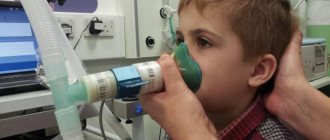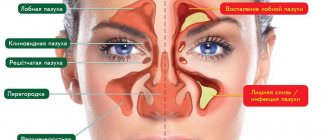The occurrence of chest pain when coughing is always alarming, especially if there is no corresponding reason for this. Very often, such pain occurs due to inflammation of the human respiratory system during various respiratory infections. But there are cases when this condition characterizes completely different diseases.
To properly deal with chest pain, you need to study all possible ways of its occurrence and try to prevent the onset of the disease. If you have any signs, you need to contact an experienced specialist as soon as possible and get information about how and with what to treat this disease.
Why are coughing attacks accompanied by pain?
The causes of chest pain during coughing are numerous. Most often this phenomenon occurs in the presence of the following pathological conditions:
- ARVI and other colds;
- diseases of the cardiovascular system, heart failure;
- allergic reaction, attack of bronchial asthma;
- acute or exacerbation of chronic bronchitis;
- oncological pathology;
- pneumonia;
- epiglottitis – inflammation of the epiglottis;
- tracheitis, pleurisy and other inflammatory diseases.
Depending on the cause of the pain, its location, severity and other parameters change.
What to do if you have chest pain due to bronchitis?
Chest pain with bronchitis is a very serious symptom that threatens the patient with serious consequences. Treatment of diseases with the appearance of chest pain must be monitored by a doctor who will prescribe the necessary effective remedies. But it is worth remembering that if the diagnostic and treatment session is incorrect or untimely, serious heart complications are possible.
Symptoms of bronchitis
After long-term chronic diseases (ARVI, influenza, etc.), inflammation of the bronchi can form again in the respiratory tract, which leads to difficulty breathing, blockage of the bronchi with mucus and, accordingly, the appearance of cough. This is bronchitis. The cause of bronchitis is often not only a viral infection, but also pathogenic bacteria. The ingress of dust or certain poisons into the body (this includes smoking) provokes the development of the disease. Very rarely, a fungal infection can cause bronchitis.
The first and most obvious symptom of bronchitis is a cough. Most often, a dry cough appears in the early stages of the disease. After some time, it may be replaced by a wet cough, the difference of which is the discharge of mucus (sputum), which prevents the passage of air in the bronchi.
Chest pain appears. When the disease lasts long enough, chills are added to the symptoms and, a little less often, increased body temperature. If the cough is very intense, a constant headache may occur.
It is important to remember that in rare cases, when bronchitis develops, a chronic cough may not be present. However, other symptoms of the disease will make themselves felt.
How to distinguish bronchitis from pneumonia
Bronchitis and pneumonia are very similar diseases in manifestation, so it is quite easy to make a mistake in making a diagnosis based on external symptoms. Still, there are several significant differences:
- A viral infection (influenza, ARVI, chicken pox) very rarely causes pneumonia. This can only happen in cases of extremely weakened immunity.
- Differences in the general condition of the patient. If the cause of the disease is pneumonia, a state of general intoxication is observed. But with bronchitis, in the first days a dry cough appears and there is a feeling of lack of air.
- The location of the chest pain indicates the nature of the disease. If constant pain occurs approximately behind the sternum, then this is bronchitis. If you feel pain in one (damaged) side of your chest, this is pneumonia.
Despite all these signs, the most reliable way to get rid of doubts is, of course, radiography. This is how you can accurately determine the diagnosis and choose the optimal treatment.
What is the difference between acute and chronic bronchitis
It would seem that the terms are similar, but each of them defines different stages of the disease.
Acute bronchitis lasts on average 10 days. During this time, you may again experience a dry and wet cough, chills and an increase in temperature up to 39 degrees. Fatigue, headaches and insomnia are common symptoms experienced by a patient with acute bronchitis.
If the course of treatment does not help and you do not suffer from chronic bronchitis, then you need to conduct an additional examination to identify the cause of such a long-lasting illness.
Chronic bronchitis is the most common chronic nonspecific lung disease.
It lasts in acute form for about three months a year and can last for several years.
The causes of this stage of the disease can often be smoking, constant exposure to dust and other abiotic substances in the body, and prolonged exposure to dry, cold air.
Why does chest pain occur?
As noted earlier, the primary source of bronchitis is inflammation of the bronchi. However, the bronchi themselves cannot hurt. Chest pain is the result of a reaction of respiratory tract receptors to constant contractions (coughing) or some other irritant.
The sources of chest pain are varied. This is not only the chest area. Foci of pain may appear in the sides or back.
The cause of pain can be not only bronchitis!
You can never say for sure whether chest pain is a symptom of bronchitis. A similar symptom can be evidence of a number of other diseases, sometimes more or less serious:
- Pleurisy. There is acute pain in the chest area. It gets worse not only with intense coughing, but also with laughing or sighing.
- Tracheitis. An alternative disease when the tracheal membrane becomes inflamed. In most cases, the pain is felt on the left side of the chest.
- Pneumonia. A severe respiratory disease requiring long-term drug treatment.
- Tuberculosis. A very serious illness that requires intensive treatment.
Sometimes the causes of pain can also be heart disease (myocardial infarction, angina), injuries to the chest and spine, damage to organs anatomically located under the right breast (liver, gall bladder, part of the intestine and diaphragm). To this list you can add acute leukemia, vegetative-vascular dystonia, osteochondrosis, hernia.
Treatment for chest pain
Important! Any disease accompanied by chest and back pain must be monitored by a doctor, because there are a lot of such diseases and they can be of varying degrees of severity.
It all depends on the current stage of the disease. Commonly accepted remedies are any expectorant type medications. If the source of the disease was a virus, anti-infective drugs are used. Similarly, antibiotics are used orally against bacterial pathogens.
During the treatment of the disease, you can perform special simple gymnastics that speed up the clearing of mucus from the respiratory tract. There are some useful general guidelines:
- compliance with bed rest;
- in emergency cases, use antipyretics;
- drinking plenty of fluids.
These three simple rules will bring you as close as possible to recovery, along with drug treatment.
Doctors recommend, if possible, carrying out inhalation sessions and taking vitamins both in the form of products and in the form of special means. No one has canceled mustard plasters, compresses, cups, which will definitely help you on the path to recovery. However, it must be remembered that these home remedies are not effective against the disease in the later stages of development.
If you experience chest pain due to an allergy, it is strongly recommended to minimize contact with the allergen.
At a mild or moderate stage of bronchitis, you can sometimes use traditional methods to relieve chest pain.
Of course, traditional medicine is associated with herbal infusions. For bronchitis and some other respiratory diseases, you can prepare a decoction of linden flowers, elderberries, sage leaves, raspberry leaves and berries. Each of the above ingredients is taken in equal quantities. 2 tablespoons of the resulting mixture should be mixed with boiling water and left for an hour. Be sure to take this decoction before bed to get the maximum effect;
You can make tea. To prepare the drink, it is recommended to use cherry stems. If you drink this tea throughout the day, chest pain and general condition will noticeably improve.
And of course, it is very important to focus your efforts on increasing the body’s overall resistance to diseases. Good immunity is a guaranteed ticket to a healthy life. Therefore, you need to remember about a balanced diet, again because of vitamins, and about bed rest.
respiratoria.ru
Types of pain
The nature and localization of pain in the chest after coughing in a child or adult are determined by the disease that caused the appearance of this symptom. For example, if the cause of concern is a chest injury, the pain will intensify at the height of inspiration and during physical activity.
In diagnosing the disease, along with the nature of the pain, its localization is important. Often this is the only way to determine which pathology caused the symptom.
Dry cough with chest pain
The so-called barking cough can accompany many infectious colds, in which inflammation develops in the upper respiratory tract. This may be laryngitis, tracheitis, some types of bronchitis and other pathologies.
Dry cough and chest pain also often occur in the early stages of inflammatory diseases of the respiratory tract. During this period, there are inflammatory changes in the mucous membrane, but sputum is not produced in large quantities.
Important! If the patient coughs for a long time, pain occurs in the intercostal muscles and lower part of the chest. This is the main difference from pathologies such as pleurisy, when pain appears due to irritation of receptors located on the pleura - the serous membrane of the lungs.
Pain in the middle of the chest
The cause of pain in the middle of the chest is usually associated with damage to the trachea or mediastinum. The following conditions most often lead to this:
- damage to the interpleural ligament, its shortening;
- entry of a foreign body into the respiratory tract;
- mediastinal tumors.
In the diagnosis of the conditions listed above, the nature of pain plays an important role. For example, when a foreign body enters, symptoms arise suddenly, a feeling of lack of air, suffocation, and a blue face appears. If this phenomenon is associated with cancer, it will bother the patient for a long period of time. The intensity of symptoms will gradually increase, starting with a slight cough and mild, intermittent pain.
Pain on the sides of the chest
The occurrence of pain on the right or left when coughing is most often associated with inflammatory damage to the lungs or surrounding tissue. This condition can occur with the following pathologies:
- neuralgia of the intercostal nerves - in this case, there is chest pain when changing body position. When the patient is at rest, nothing bothers him. When pressed, there is pain under the skin in the affected areas. This feature makes it possible to determine the localization of pathological changes in the nerves;
- pleurisy – inflammation of the pleura. It usually develops against the background of an existing infectious pathology, for example, pneumonia. In this case, shortness of breath, a feeling of lack of air, pain when breathing, and a significant increase in temperature occur;
- pulmonary tuberculosis - in severe cases, a severe cough occurs, which leads to chest pain. You can often notice the presence of blood streaks in the sputum, which indicates the breakdown of lung tissue.
If pain or a burning sensation is noted in the left half of the chest, the presence of diseases of the cardiovascular system should be suspected. This is the most common symptom of an angina attack. Its characteristic feature is that it occurs during physical activity, walking, emotional stress and disappears with rest. If such symptoms appear, you should consult a doctor as soon as possible.
What measures to take?
If coughing attacks occur that cause pain in the sternum, the patient’s condition can be slightly alleviated. But you should refuse self-treatment in cases where the cause of such a process is unknown. If the patient knows that chest pain when coughing occurs as a result of muscle strain, a warming ointment can be used. You need to buy the ointment as prescribed by your doctor, apply it to the sore spot and rub in well so that the affected area is hot. Such actions must be done for 3 days, during which time the inflammatory process will subside.
It is also recommended to take medications that suppress cough attacks or drugs that increase the amount of sputum and promote its removal. Chest pain when coughing is in any case an indicator of disturbances occurring in the functioning of the body, which is why it is important to consult a specialist as early as possible.
If you have questions for your doctor, please ask them on the consultation page. To do this, click on the button:
Ask a Question
Related Posts
- Types of bronchitis in children: symptoms, causes and treatment
- Whooping cough in children: signs and treatment
- Breathing exercises for coughs in children
- Tracheitis and bronchitis: symptoms and traditional methods of treatment
One comment on ““What to do and what to be wary of when your chest starts to hurt during coughing attacks?””
- Courtney Love:
11/30/2015 at 02:59
It was during bronchitis that I experienced chest pain when coughing. but everything ended well, I was cured. The thematic site helped a lot then: https://bronchitis-treatment.rf I will be glad if it is also useful to someone
Login to reply
Diagnosis – which doctor to contact?
If you experience a severe cough and chest pain, you should consult a general practitioner as soon as possible. To determine the cause of the symptom, the doctor will prescribe the following diagnostic procedures:
- general and biochemical blood tests;
- serological blood tests to determine the presence of infectious agents in it;
- analysis and culture of sputum, in which bacteria can be detected;
- ECG, Echo-CG to determine the functional state of the heart;
- X-ray of the lungs in one or two projections;
- if pulmonary tuberculosis is suspected, a tuberculin test.
If an X-ray examination reveals the presence of a space-occupying lesion in the lungs, a suspicion of cancer may arise. In order to determine the type of tumor, a puncture of the lungs is performed with the collection of a small amount of tissue - a biopsy.
To diagnose inflammatory infectious diseases, when there is a cough and fever, it is necessary to carry out not only radiography, but also methods aimed at identifying the pathogen. Therefore, the therapist may prescribe sputum and blood tests. Identification of the pathogen is necessary in order to select the most effective treatment aimed at eliminating the cause of the disease.
What is a chest cough?
Chest cough appears regardless of the age and condition of a person. This could be a child, a pregnant woman, a man or an elderly woman. In adults, this type of reflex occurs less frequently than in children. The cause is called microorganisms of pathogenic origin.
Bacteria and viruses enter the body by airborne droplets and quickly affect the respiratory system. The receptors are irritated, and muscle tissue of the respiratory tract contracts.
The result is a reflex called cough spasm, bronchial spasm or cough. The bronchi are diligently trying to cleanse themselves, expel the bacteria and viruses that have entered them.
But why is cough called chest cough? There is a difference between the resulting reflex called the throat reflex. All progress occurs directly in the throat, capturing the ligaments, causing soreness and itching. But everything happens only on the back wall of the throat. Without penetration into the lower respiratory tract.
Chest cough in adults and children can be treated only after the type has been established. And it comes in both types:
- A wet (wet, productive) cough is fundamentally different from a non-productive one. During coughing, sputum of varying consistency comes out. Blood, inclusions, and pus may be observed. Thanks to such waste, the respiratory system removes pathogenic microbes, dust, and any irritants. The appearance of discomfort and pain accompanies a wet chest cough. Location: sternum, back, heart area.
- Patients with chest discomfort may cough, but there is no discharge. This is the dry look. The pain is strong. When described, they are characterized by tearing, with strong tremors, causing nausea and vomiting. The headache gets worse. Pulsation is often felt in the temples and the back of the head. It occurs mainly at night, which prevents you from getting proper rest.
Regardless of the type of chest cough, it seems to the patient that it originates in the lungs. But this is not always confirmed. Only after determining the causes can one say with certainty where the chest spasm is projected.
Treatment methods
Therapy for diseases that are accompanied by cough and chest pain is selected depending on the cause. If the pain is associated with intercostal neuralgia, anti-inflammatory drugs (Indomethacin, Diclofenac, etc.) are prescribed. For pulmonary tuberculosis, the use of strong antibacterial drugs is indicated.
Since chest pain in children and adults is most often associated with colds, the doctor in most cases prescribes the following medications:
- when the temperature rises above 38 degrees - antipyretics (Panadol, Nimesil, etc.);
- to combat the infectious agent - antiviral drugs (Arbidol, Kagocel, etc.);
- with the development of bacterial complications, pneumonia, severe bronchitis - broad-spectrum antibiotics, for example, Amoxicillin, Augmentin;
- to improve sputum discharge - mucolytics and expectorants (ACC, Gerbion, Gedelix, etc.)
In addition to drug treatment, physical therapy and other supportive methods are also indicated.
Treatment options
There are no universal tablets for chest cough. You will need a clearly formed scheme that will help quickly remove both additional and primary symptoms. During pregnancy or childhood, it is difficult to find the right medications and traditional recipes. This should be done by a specialist.
When selecting medications, the doctor studies not only the current state of affairs, but also looks at previous diseases that can intensify the coughing process and complicate the transition of an unproductive cough to a productive one.
It is worth paying special attention to side effects, contraindications and possible combinations of drugs.
Medicines
With the help of diagnostics, a diagnosis is established, a provocateur is identified, to which the therapeutic effect will be directed. The approach is multifaceted. Dosage forms are used with different spectrum and mechanism of action.
If viruses are present, antibiotics will be required, which are combined with antitussive tablets and syrups (codeine, libexin). Inhalations, rinsing, rubbing and applying aromatic oils (eucalyptus, pine, menthol, anise) will bring benefits.
An excellent cough remedy: Terpinod or Codelac. But they are not able to help if the cough is allergic in nature. Such cases require the attention not of a therapist, but of an allergist.
If an allergy is excluded, but a substance suitable for all age groups is required, then you can use Gerbion, Dr. MOM or Theiss. These medications will help speed up the coughing process.
They increase the activity of bronchial cilia and soften the mucous membrane. Simultaneously with this effect, due to the plant component, they strengthen and restore the protective functions of the body.
Folk remedies
The recipes offered by herbalists deserve attention, as they are the basis for most modern cough tablets, syrups and other dosage forms.
If time permits, you can always use breast mixtures and herbs separately. But such options are not suitable for everyone, and if you have to treat a baby, they may not do a very good job.
For the safest treatment, it is recommended to drink more warm liquids, do inhalations, and potato cakes. And at all times, milk with honey and soda gave the necessary result - the removal of sputum, the restoration of cough receptors.
Mustard plasters or flatbreads based on mustard powder are suitable. Chamomile is also useful, suitable for relieving inflammatory processes in both the upper and lower respiratory tract. A feature of the proposed methods of eliminating cough is the possibility of combining it with drug therapy without the presence of consequences or adverse reactions.
Folk remedies
Home methods of cough therapy should be used only for colds as an addition to the main treatment. These methods are not effective enough to independently cope with the cause of the disease.
A few examples of folk remedies that will help reduce the severity of cough in ARVI and other pathologies:
- tea with honey and lemon – to prepare it you need to add a few tablespoons of honey or 1-2 slices of lemon to a glass of hot black tea. It is recommended to drink the drink at least 4-5 times a day;
- ginger tea - take a glass of hot black tea, add one spoon of chopped ginger to it, and then leave for an hour. The resulting product should be drunk several times a day after meals;
- inhalation of vapors of essential oils - this remedy will help transform the cough from dry to wet form, improve coughing up sputum. It is recommended to add a couple of drops of eucalyptus or peppermint oil to hot water. You can inhale the vapors using a special inhaler or while taking a bath.
Chest pain when coughing is an unpleasant symptom that can be associated with serious illnesses. If it appears, you should immediately consult a doctor to determine the cause of the concern and begin treatment.
Chest pain when coughing: causes and treatment
Quite often there are cases when a person gets sick, feels unwell and feels discomfort when coughing. This indicates a sign of inflammation of the trachea (breathing tube). This cough may disappear along with the cold. The reason for chest pain is that the cough begins to appear as a result of contraction of the diaphragm muscles, so pain is felt with sudden contractions.
Causes of chest pain when coughing
1. A cough may appear with acute bronchitis, asthma or pneumonia. With bronchitis, sputum is usually produced, and the cough can be paroxysmal. Coughing can sometimes be so frequent that a person can even faint or suffer from a severe headache. And in general, pain can lead to many complications;
2. As for young children, their cough occurs as a result of respiratory infections. Inflammatory processes in children under three years of age can spread to the larynx. In such cases, a hoarse cough and shortness of breath are observed;
3. Pain may occur due to stress or anxiety;
4. Pain with sudden movements, which intensifies with a deep breath. This pain can be traumatic in nature. Its location can be clearly identified by pressing on the chest;
5. If the pain goes away along with the cough, then this may be a stretch of the intercostal muscles. This phenomenon can accompany a large number of diseases of the bronchi and lungs. This is, for example,
- pharyngitis,
- bronchitis,
- pneumonia,
- tuberculosis
- and even lung cancer.
6. Pain can occur when the membrane that lines the inside of the chest cavity and covers the lungs becomes inflamed. Most often, dry pleurisy occurs due to pneumonia, and pain in the chest is felt especially strongly if the patient leans on the affected side.
7. If your chest hurts when you cough, this may indicate functional disorders of the rib cage, as well as the thoracic spine, neoplasms in the pleura, and pericarditis.
8. Dry pericarditis is characterized by pain during coughing, inhalation and movement; for this reason, the patient’s depth of breathing is impaired and shortness of breath worsens because of this. The intensity of pain can be either slight or severe.
9. Constant coughing may indicate shortening of the interpleural ligament; coughing intensifies during conversation, deep breaths and physical activity.
10. Also, acute pain, which intensifies during coughing, can occur due to intercostal neuralgia. Pain can result from fractured ribs or osteochondrosis of the thoracic region.
11. If a person is sick with the flu or acute respiratory viral infection, and when coughing he experiences chest pain, then this indicates the development of an inflammatory process in the trachea - that is, tracheitis. The trachea is a tube that connects the larynx and bronchi. The pain goes away along with the disease. With a strong, constant cough, pain may appear at the level of the lower ribs; this occurs because the muscles of the diaphragm contract, and with prolonged work it simply gets tired, and therefore pain appears during its subsequent sharp contractions.
12. If malignant neoplasms appear in a person’s lungs, the pain can be sharp or stabbing, or girdling. It can manifest itself in the entire chest or only part of it, and can radiate to the arms and neck. If the tumor grows into the spine and ribs, the pain becomes more intense.
Causes of chest pain with dry cough
Such symptoms can be observed in a person when some inflammatory processes occur in his body.
1. Pain can occur when the membrane that lines the inside of the chest cavity and covers the lungs becomes inflamed. Most often, dry pleurisy is a consequence of the development of pneumonia, and pain in the chest is felt especially strongly if the patient leans on the affected side.
2. If your chest hurts when you cough, this may indicate functional disorders of the rib cage, as well as the thoracic spine, neoplasms in the pleura, and pericarditis.
3. Dry pericarditis is characterized by pain during coughing, inhalation and movement, because of this the patient’s depth of breathing is impaired and shortness of breath worsens. The intensity of pain can be either slight or severe.
4. Constant coughing may indicate shortening of the interpleural ligament; coughing intensifies during conversation, deep breaths and physical activity.
5. Also, acute pain can be a consequence of intercostal neuralgia. Chest pain when coughing can result from fractured ribs or osteochondrosis of the thoracic region.
6. If a person is sick with the flu or acute respiratory viral infection, and when coughing he experiences pain in the chest area, then this indicates the development of an inflammatory process in the trachea - that is, tracheitis. The trachea is a tube that connects the larynx and bronchi. The pain goes away along with the disease.
7. A dry cough can be a consequence of a cold, flu, or other respiratory diseases, but if it lasts more than two weeks, then it is called chronic. It can also occur as a result of smoking and as an allergic reaction. A person may feel wheezing in the chest, but the cough will remain dry due to the low production of sputum by the bronchi or due to its excessive viscosity.
8. A dry cough in the chest can appear with the development of diseases in the body such as flu, colds, appears after hypothermia, or as a result of infection in the lung tissue, that is, the development of bronchitis, pneumonia. Chronic lung pathology - bronchial asthma, chronic bronchitis - cause a severe dry paroxysmal cough.
9. Paroxysmal dry cough appears as a result of diseases of the external auditory canal, gastric and food reflux. Other causes of pain are not associated with inflammatory processes in the body; cough can occur as a result of foreign bodies entering the respiratory tract, as a result of smoking, allergies, or the use of certain drugs.
10. With a strong, constant cough, pain in the chest may appear at the level of the lower ribs, this happens because when coughing the muscles of the diaphragm contract, and with prolonged work it simply gets tired, and therefore pain appears during its subsequent sharp contractions.
11. If malignant neoplasms appear in a person’s lungs, the pain can be sharp or stabbing, or girdling. It can manifest itself in the entire chest or only part of it, and can radiate to the arms and neck. If the tumor grows into the spine and ribs, the pain becomes more intense.
12. Pain is also observed with pneumothorax: it can be both severe and moderate.
Other causes of chest pain besides cough
We can distinguish types of diseases in which similar symptoms appear:
1. myocardial infarction,
2. pneumonia,
3. inflammation of the bladder,
5. cholecystitis,
6. pancreatitis;
Basically, chest pain not due to cough and other diseases of the bronchopulmonary system appears during acute myocardial infarction. At the same time, the skin becomes pale, the level of sweating increases, and blood pressure decreases. The only way to get rid of such pain is to call an ambulance.
Features of the treatment of chest pain when coughing
Treatment can occur by taking medications such as tablets or syrup. If the cough occurs as a result of prolonged smoking, then this harmful habit should be abandoned. If a strong dry cough torments you at night, then you should change the angle of the pillow, since in a horizontal position, mucus intensively flows down the back wall of the larynx and irritates it.
A traditional method of treating chest pain associated with a dry cough involves drinking a lot of hot liquid, for example, hot tea or milk. This contributes to the transition of a dry cough into a productive one and a speedy recovery.
Chest pain that appears suddenly can lead a person to painful shock and loss of consciousness, so you should urgently call an ambulance. To get rid of chest pain before the ambulance arrives, you need to take a painkiller, put a Nitroglycerin tablet under your tongue and take a comfortable position in which the body should be relaxed.
In any case, no matter what the pain and discomfort, you yourself are unlikely to be able to determine the correct diagnosis, so a visit to the doctor should be mandatory! Take this seriously to avoid even more unpleasant consequences later. If, for example, you have diabetes or chronic lung diseases, heart problems, then treatment should be carried out under the supervision of a doctor - a specialist who will conduct the necessary examination, establish the correct diagnosis and prescribe the correct treatment, which should be effective. Do not treat yourself under any circumstances, so as not to harm your health!
Diagnosis for chest pain and cough
Chest pain can be a sign of various diseases and not a diagnosis. How severe the pain is and what the cause of the pain is, you can only with professional help.
To get rid of the disease, the main thing for the doctor is to correctly determine the exact cause of pain in the chest when coughing. Perhaps this is oxygen starvation of the heart muscle, inflammation of the pleura, a rib fracture or inflammation of the cartilaginous part of the rib, etc.
The main thing to do in this case is:
1. measure pulse and blood pressure;
2. do an electrocardiogram;
3. insert a catheter into the vein;
4. get rid of pain by administering the necessary medications.
AstroMeridian.ru
Diagnostic measures
To determine the cause of this condition, as well as prescribe the necessary cough therapy, the doctor must carry out the following diagnostic procedures:
- General clinical blood test.
- Specific tests for the presence of pathogens.
- Bacterial culture of sputum.
- ECG, echocardiography, if necessary - coronary angiography.
- X-ray examination, if necessary CT or MRI.
- Phthisiatrician consultation.
If there is a suspicion of an oncological process, it is necessary to puncture the tumor for histological examination.
A chest x-ray will help determine the cause of pain when coughing
What can cause pain?
The synchronous interaction of such a large number of muscles can provoke small contractions in related areas of the body. And if there is a pathology in them, then a person’s chest hurts after coughing. However, if the pain is one-time and does not recur, then there is most likely nothing to worry about, since a single spasm can be caused by incorrect body position, heavy lifting, or active sports.
Possible etiologies for why chest hurts when coughing may be diseases of the cardiovascular system, respiratory system, gastrointestinal tract, spine, various neuralgia, tumor processes and neoplasms of the chest, including in the mammary glands in women, inflammatory processes in the muscles .
Determining the etiology of pain
When a strong cough causes chest pain for more than 5 days (7 days after a cold or ARVI), or the pain is very sharp, stabbing, unbearable, you should immediately consult a specialist to rule out dangerous diseases that pose a threat to life.
Doctors prescribe diagnostic procedures for the heart muscle and blood vessels, then the lungs and stomach and other internal organs in the chest area for tumors.
After a thorough examination of the functional state of the internal organs, specialists will be able to make an accurate diagnosis and prescribe comprehensive treatment for the pathology. How to treat a patient who has had chest pain from coughing for a long time must be decided by the doctor; self-medication can lead to negative health consequences. The most positive and rapid results are obtained in the treatment of early stages and initial forms of diseases.











